A long time ago, when I lived at Arcosanti, I learned how to find True North from Tomiaki Tamura by using a plumb line, string and a drafting compass. If I'm remembering correctly, Tomiaki tacked a small nail into a slab of concrete (there are a lot of flat slabs of concrete at Arcosanti).
I'd always wondered where North was in relationship to our house. I'd done a quick and dirty siting off of Polaris (which is a little off of True North, but will get closer and closer until something like 2093, at which point it will get farther away again). But using the sun is supposed to be more accurate than using just Polaris.

Two weeks prior, I created a work space. I used a drill guide to drill a perpendicular hole into the side of an old crate. Then I pounded a long nail through the guide hole. The idea was to have a completely vertical gnomon coming out of a level flat plane. Then the clouds rolled in and I couldn't test my box until today.
In practice, my nail was a little bent, the drill guide was cheap, and not only was the box old, but it turned out the side that I wanted to use was slightly warped. All of these add in little measurement errors.
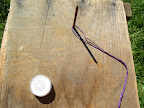
I already had a notion that our local solar noon happens around 12:20 PM, Pacific Standard Time (1:20, Pacific Daylight Time). So around noon daylight time, I set the box on the ground in our back yard. Our yard is pretty catty-wumpus, so I used a photographer's level to even out the top (this is when I discovered the top was a little warped).
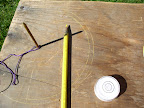
Next, I used a loop of thread and a yellow colored pencil to draw a series of circles centered on the gnomon. Ideally I would have marked the place where the tip of the nail's shadow touched each circle; but my first circle was too big. I managed to draw a second circle that was even with the shadow. I drew a third circle that I hoped would give me another reading, but it was too small, and the shadow never reached it. Source of errors: having only one set of measurements, changing the angle of the pencil may have created an imperfect circle and the thread may have stretched or moved the gnomon.
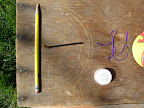
Then I waited. The shadow made an elliptical path along the top of the crate and inched toward the east side of the middle circle. Another source of error -- I'm becoming farsighted, and I had to take off my glasses to be sure I was seeing the second point correctly; this didn't occur to me when I marked the first point. When the shadow came into contact with the circle, I took off my glasses, marked the place, and got out my compass.
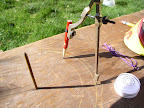
I used the points where the path of the gnomon's shadow intersected the circle as the center of two other circles. The two points where
these circles intersected defined a line which pointed (assuming that all the errors canceled each other out) to True North. I used the nail and a pencil to get a site line and placed two iron stakes at opposite sides of the yard.
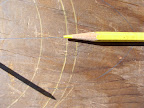
As I had suspected from my earlier siting off of Polaris, the house and the local streets are squared up with the cardinal directions (assuming, of course, that my eyeball measurements are accurate). This means that one could use the street curbs in our neighborhood to tell when local solar noon is. And our house.
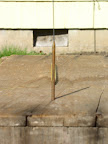
Oh -- Janet Hart gave me a good suggestion. Ideally, I could use a magnetic hiking compass to take a magnetic north reading and find out how many degrees apart magnetic north and celestial north are. Then, whenever I felt like building my own personal Stonehenge in the backyard, I could line things up with a magnetic compass.
Even on a cloudy day.
Next time, I will have to see about getting an unwarped piece of wood, an extra-straight, extra-long pipe (longer gnomon equals greater precision) and I'll have to figure out a way to use
lasers!
No comments:
Post a Comment